The Plextor M3 (256GB) Review
by Kristian Vättö on April 5, 2012 3:05 AM ESTAnandTech Storage Bench 2011
Last year we introduced our AnandTech Storage Bench, a suite of benchmarks that took traces of real OS/application usage and played them back in a repeatable manner. Anand assembled the traces out of frustration with the majority of what we have today in terms of SSD benchmarks.
Although the AnandTech Storage Bench tests did a good job of characterizing SSD performance, they weren't stressful enough. All of the tests performed less than 10GB of reads/writes and typically involved only 4GB of writes specifically. That's not even enough exceed the spare area on most SSDs. Most canned SSD benchmarks don't even come close to writing a single gigabyte of data, but that doesn't mean that simply writing 4GB is acceptable.
Originally we kept the benchmarks short enough that they wouldn't be a burden to run (~30 minutes) but long enough that they were representative of what a power user might do with their system. Later, however, we created what we refer to as the Mother of All SSD Benchmarks (MOASB). Rather than only writing 4GB of data to the drive, this benchmark writes 106.32GB. This represents the load you'd put on a drive after nearly two weeks of constant usage. And it takes a long time to run.
1) The MOASB, officially called AnandTech Storage Bench 2011—Heavy Workload, mainly focuses on the times when your I/O activity is the highest. There is a lot of downloading and application installing that happens during the course of this test. Our thinking was that it's during application installs, file copies, downloading, and multitasking with all of this that you can really notice performance differences between drives.
2) We tried to cover as many bases as possible with the software incorporated into this test. There's a lot of photo editing in Photoshop, HTML editing in Dreamweaver, web browsing, game playing/level loading (Starcraft II and WoW are both a part of the test), as well as general use stuff (application installing, virus scanning). We included a large amount of email downloading, document creation, and editing as well. To top it all off we even use Visual Studio 2008 to build Chromium during the test.
The test has 2,168,893 read operations and 1,783,447 write operations. The IO breakdown is as follows:
| AnandTech Storage Bench 2011—Heavy Workload IO Breakdown | ||||
| IO Size | % of Total | |||
| 4KB | 28% | |||
| 16KB | 10% | |||
| 32KB | 10% | |||
| 64KB | 4% | |||
Only 42% of all operations are sequential; the rest ranges from pseudo to fully random (with most falling in the pseudo-random category). Average queue depth is 4.625 IOs, with 59% of operations taking place in an IO queue of 1.
Many of you have asked for a better way to really characterize performance. Simply looking at IOPS doesn't really say much. As a result we're going to be presenting Storage Bench 2011 data in a slightly different way. We'll have performance represented as Average MB/s, with higher numbers being better. At the same time we'll be reporting how long the SSD was busy while running this test. These disk busy graphs will show you exactly how much time was shaved off by using a faster drive vs. a slower one during the course of this test. Finally, we will also break out performance into reads, writes, and combined. The reason we do this is to help balance out the fact that this test is unusually write intensive, which can often hide the benefits of a drive with good read performance.
There's also a new light workload for 2011. This is a far more reasonable, typical every day use case benchmark. It has lots of web browsing, photo editing (but with a greater focus on photo consumption), video playback, as well as some application installs and gaming. This test isn't nearly as write intensive as the MOASB but it's still multiple times more write intensive than what we were running last year.
We don't believe that these two benchmarks alone are enough to characterize the performance of a drive, but hopefully along with the rest of our tests they will help provide a better idea. The testbed for Storage Bench 2011 has changed as well. We're now using a Sandy Bridge platform with full 6Gbps support for these tests.
AnandTech Storage Bench 2011—Heavy Workload
We'll start out by looking at average data rate throughout our new heavy workload test:
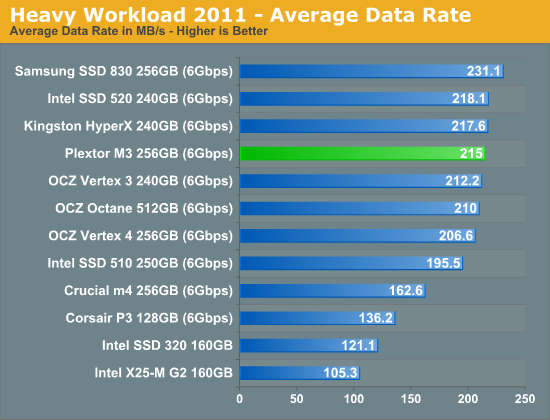
Samsung SSD 830 continues to dominate our Heavy suite but in both read and write, but the M3 is the fastest Marvell based SSD and delivers a result 32% faster than the Crucial m4. Overall the M3 is on-par with SandForce—it does worse in read speed but takes that back in write speed.
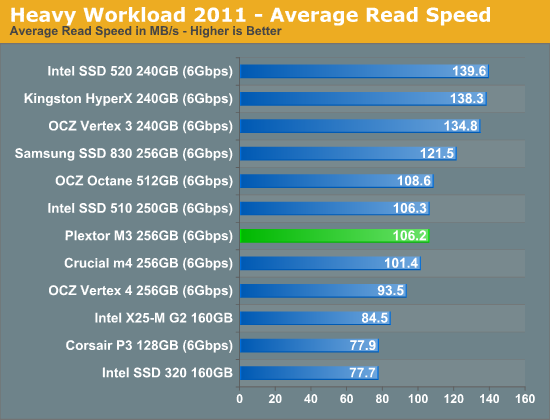
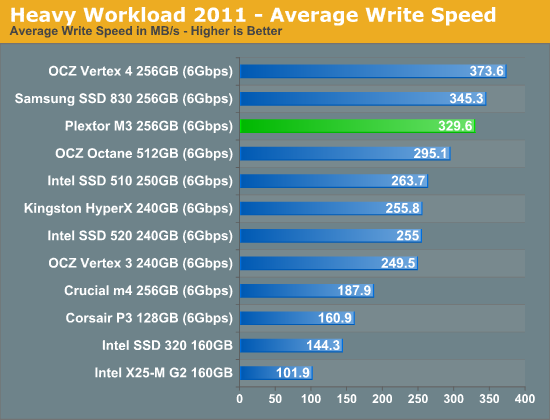
The next three charts just represent the same data, but in a different manner. Instead of looking at average data rate, we're looking at how long the disk was busy for during this entire test. Note that disk busy time excludes any and all idles; this is just how long the SSD was busy doing something:
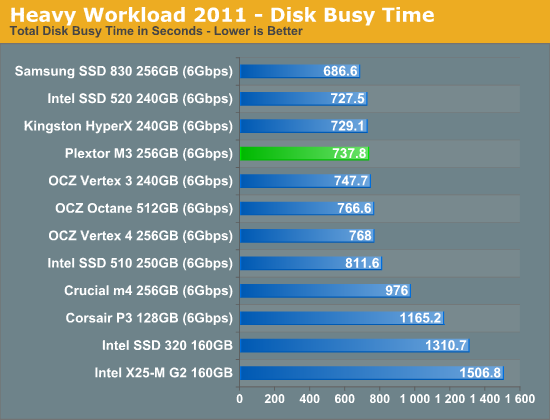
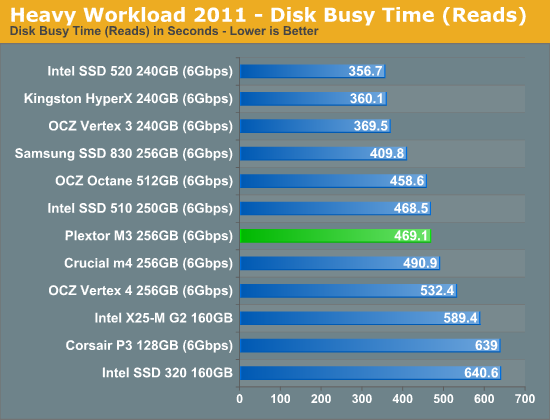
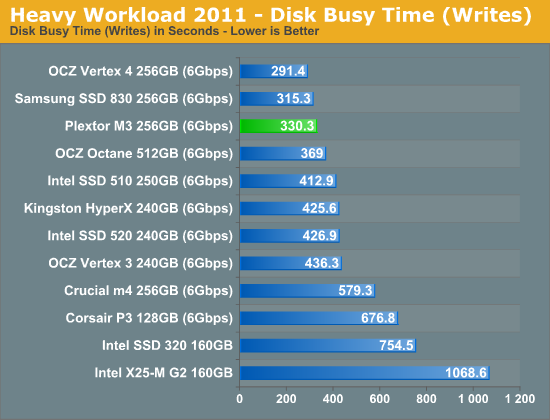










113 Comments
View All Comments
Kristian Vättö - Friday, April 6, 2012 - link
Oops! Thanks, fixed it now. I added the Vertex 4 scores right before this went live so that's why Vertex 4 is not included in any of the analyses.wvh - Thursday, April 5, 2012 - link
Back at the end of the '90s we used to burn a lot of CDs at university, and only the Plextors lasted and rarely burned coasters. It was the brand to have. In fact, the only writer that hasn't broken down on me yet is my Plextor.This isn't a shill ad – it's just a CD-writer after all – I'm just surprised to hear you've never heard of Plextor.
hrrmph - Thursday, April 5, 2012 - link
I may have missed it, but more emphasis on the inclusion (or lack) of toolbox software and what functions it provides would be appreciated. Preferably near the beginning of the review.When I look at ranking SSDs, the inclusion of toolbox software that supports Secure Erase and possibly even 'settable spare area' is important to me.
I find manual (non-toolbox) methods of Secure Erase to be overly complicated and time-consuming.
So the inclusion of toolbox software that supports Secure Erase, and thus easy maintainability is important.
Settable spare area is also nice, because I'm willing to buy an SSD that is the next size up just to get some more spare area, because reliability is extremely important to me.
So when reading a review, while it's nice to know that the manufacturer took the time to provide good firmware and good validation (I'm not sure that validation was well-covered in this review either), it's also very nice if I can quickly 'suss out' whether the manufacturer took the time to make a good toolbox.
To my knowledge, only Intel, OCZ, and Samsung provide a toolbox that allows for easy Secure Erase from inside Windows, assuming the drive is connected to a machine as a secondary drive.
Similarly, I think that only Samsung is allowing settable spare area in their toolbox.
I usually eliminate OCZ from consideration these days because Intel and Samsung provide very adequate alternatives, and most importantly, I saw OCZ forum moderators horribly and publicly abusing some of the other OCZ customers. So while I wasn't abused by OCZ when I was a customer of theirs, I saw the potential.
Coming back to reviews, AT still writes the best reviews in my opinion. I like the non-emotional tone, and the long length, detail, and insightful analysis included in the reviews make them stand out from the crowd.
Other review sites tend to miss even basic points, or worse, they get breathlessly emotional and sensationalist over small differences in the various products. I think AT knows when something is worth getting worked up over, and when it's just run of the mill.
My understanding of the review, is that the Plextor M3 256GB is run of the mill.
I hope I'm not missing something here :).
-
Anand Lal Shimpi - Thursday, April 5, 2012 - link
i agree wholeheartedly - Samsung's toolbox is definitely the new gold standard here. I've been pushing folks behind the scenes to ramp up the quality of their options as well. I want to start paying more attention to it as it's a huge part of the user experience.Take care,
Anand
Kristian Vättö - Friday, April 6, 2012 - link
Unfortunately, there is no toolbox software included in Plextor M3. I have to say I'm not a fan of secure erase either, especially during write tests because this is starting to feel like work!I'll definitely try to concentrate more on the software in future reviews as several readers have requested it :-)
Coup27 - Friday, April 6, 2012 - link
I'm a massive Samsung fan and I have a contact there who says Samsung will be releasing an updated ssd magician either this month or next which will also report ssd life like Intels do. Think they realised disabling the smart values to do it yourself was a mistake, esp if u want to put one in a server.cooldadd - Thursday, April 5, 2012 - link
Kristian, I commend your writeup. New and capable talents are welcome in this arena... You will certainly have a chorus of voices with earlier/other perspectives, but they in their own way will bring you "up to date" on history prior to your entry into the mix!We are living in an amazing frenzy of technical advancement. Thirty years into the development of the telephone, for instance, not only would few people have been able to have technical discussions over its progress, but there was no popularly-available medium in which to discuss it!
I discovered AnandTech when it was new, sixteen years into my mainframe career, started by a young person like yourself who happened have a sharp technical curiosity and an ability to write well. I hope your contributions will follow in similar fashion.
Bozo - Friday, April 6, 2012 - link
I must be getting old...Back when burnable CDs came out you needed a SCSI burner like 'Smart & Friendly' to make more good CDs than coasters. Then Plextor introduced one of the first PCI burners that actually made more good CDs than coasters. It was the CD burner to have if you were serious about making usable CDs.
I feel old.
sbmeirow - Friday, April 6, 2012 - link
If you haven't heard of Plextor, then you are a newbie, and I don't read articles written by n00b's.Coup27 - Friday, April 6, 2012 - link
Idiot.